|
|
| |
|
COLLECTING 007 – Original Soundtrack Recordings |
|
|
Casino Royale was
issued on record in the UK by RCA Victor (SF 7874 Stereo/RD 7874 mono) in
1967, but it is the original USA first pressing from Columbia's ‘Colgems’
Records that audiophiles have sought out since its original release.
Casino Royale was recorded at the Cine-Tele Sound Studios (CTS) in
London from Saturday 21st to Sunday 29th January 1967, where composer Burt
Bacharach conducted between 50 and 60 musicians on more than 100 different
cues, which amounted to over 60-minutes of music. American Phil Ramone
(1934-2013) was the producer, but UK union rules prevented him from
engineering the recording, so CTS employee Jack Clegg became the actual
sound engineer. Ramone would later produce the On Her Majesty's Secret
Service soundtrack album that was also recorded at CTS in Bayswater
in September/October 1969.
What was unusual about the recording of the music for Casino Royale was
the way Jack Clegg pushed the limits of the equipment, and how this was
recorded onto the three-track Agfa magnetic master tape. This very risky,
but finely-engineered method produced what turned out to be one of the
most highly respected LPs ever made. For this reason the Casino Royale soundtrack
became highly sought after by audiophiles wishing to test the limits of
their own stereo equipment.
Casino Royale has divided fans and film critics alike since its
original release, with many even refusing to acknowledge it as a James
Bond film at all, as it did not originate from the same stable as the EON
Productions series. Regardless of its troubled production history,
and the fact Casino Royale is a comedy, the film is
loosely based on the first novel by author Ian Fleming, and does include
many characters from that story, including James Bond (several 007's in
fact!). If little else, Casino Royale gave the world the wonderful
song ‘The Look of Love’ - recorded specifically for the film by Dusty
Springfield, and in the process became a standard, one of the most popular
and oft-covered songs of all time. |
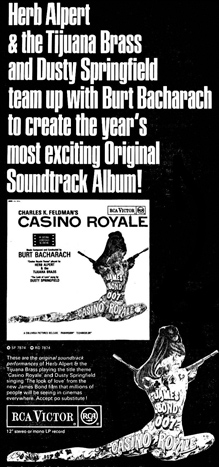 |
|
|
Casino Royale Colgems COMO-5005/COSO-5005 (1967) |
|
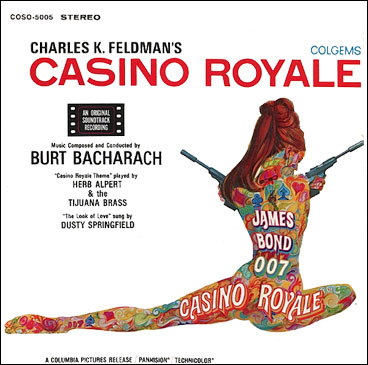 |
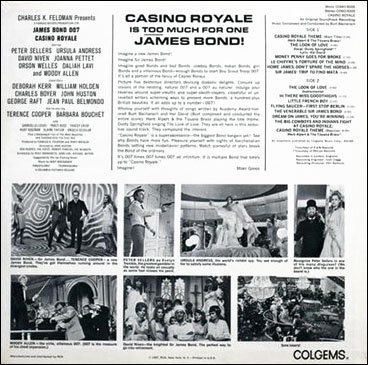 |
|
Casino Royale
Original Soundtrack Recording
Colgems COMO-5005 Mono (1967)
Colgems COSO-5005 Stereo (1967) |
|
|
|
In 1991 the New
York Times published an article by Richard Panek featuring an
interview with Harry Pearson (1937-2014), the American journalist, audio
reviewer, and publisher who founded The Absolute Sound magazine for
high-end audio enthusiasts. Harry Pearson is considered the most
influential figure in the history of audiophile journalism.
‘Casino Royale’ Is an
LP Bond With a Gilt Edge
The New York Times Sunday July 28, 1991
[excerpts]
As vinyl verges on extinction, one album has emerged as the prime specimen
of the species. Of all the millions of recordings released in the 114
years since Thomas Edison said, “What hath God wrought?” [Subsequently
corrected by the New York Times to “Mary had a little lamb”]
this album has come closest to achieving the potential of a vanishing
medium. It represents “the paradigm,” says one audiophile, “the paramount,
if you will.”
It is... the original soundtrack of the 1967 movie Casino Royale.
This unlikely choice - a jaunty Burt Bacharach score for a James Bond
spoof - makes sense only if one disregards traditional criteria for liking
an album. Collectors of Casino Royale aren't necessarily interested
in the music. “Some people enjoy it,” says one rare-record dealer,
shrugging. “Some people can't stand it.”
What interests
audiophiles is the quality of sound. They swap stories about the legendary
recording session in London, spend hundreds of dollars for a pristine copy
if and when they can find one, and then, like oenophiles who wouldn't
dream of opening a 1945 Lafite-Rothschild, often refuse to listen
to it. So volatile is the market for this LP that any nugget of news that
enhances its considerable mystique can affect the price - and some
significant new information, about the deteriorating condition of the
master tape, indicates that the price is about to rise dramatically.
The Casino Royale movie is memorable mostly as an artifact of its
era. The producer, Charles K. Feldman, who had bought the rights to Ian
Fleming's first James Bond novel before the movie series became a hit,
conceived of Casino Royale as the film that would out-Bond Bond. He
threw $12 million, five credited directors and a host of uncredited
screenwriters at the material. He assembled a cast that included Peter
Sellers, David Niven and Woody Allen - but not Sean Connery - as only
three of the movie's various James Bonds. And he hired the hottest movie
composer of the time, Mr. Bacharach, who in turn enlisted Herb Alpert and
the Tijuana Brass to play the title cut.
The soundtrack, like
everything else about the movie, was over the top. “The legend is that the
original master tape had ‘mad’ levels on it,” says Harry Pearson, editor
and publisher of the audiophile bible The Absolute Sound
and, by general consensus, the person most responsible for creating the
Casino Royale cult.
|
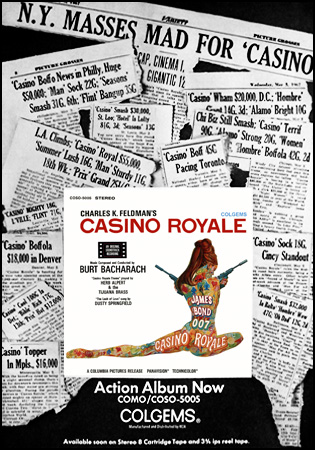 |
Mr. Pearson explains that
a sound engineer usually adjusts recording levels so that when musicians
are playing their loudest, the meters on the console reach zero. “Once the
meters pass zero, it means that you're saturating the tape and running the
risk of distortion,” he says. “On ‘Casino,’ they used a supposedly very
fancy grade of tape, and the engineers really pushed it, so the meters
were typically running deep into the red - plus one, plus two, plus three,
plus four.” As a result, he says, the record has an “extremely wide
dynamic range” - higher highs and lower lows.
“They weren't afraid to push the medium to the limits of the recording
process,” Mr. Pearson adds. “It can lead to disaster, but in the case of
‘Casino,’ it doesn't. There's no saturation, no distortion. The record is
as clean as a whistle.”
For this reason, ever since the album's release, audiophiles have valued
Casino Royale as a test for stereo equipment. “The better your
system gets,” says Mr. Pearson, “the more you get out of that album.”
|
|
‘The Look of Love’
provides several such tests. Dusty Springfield recorded her vocal in a
“tiny isolation booth, so on a really good system, you can hear her voice
emerging from what sounds like a little hole in space,” Mr. Pearson says.
“She's not part of the general orchestral acoustic, and once your system
gets to a certain point, you can hear that.”
The song also features a sudden saxophone dip and rise that, on less
sophisticated equipment, sounds like two or three distinct instruments,
and a serrated gourd called a guirot, whose every notch will sound, under
ideal conditions, Mr. Pearson says, “like a tooth on a comb. A normal
sound system simply can't reproduce this series of very quick transients”
- stiff sound waves - “at a very soft level. Just cannot do it.”
Mr. Pearson founded
The Absolute Sound in 1973 when he was still an environmental reporter
for Newsday, and he tries to apply objective reporting to the
subjective experience of listening to music. “Whenever we get a piece of
equipment that we think is setting new records,” he says, “out comes
‘Casino.’” Mr. Pearson has often
cited the record in The Absolute Sound, which has a circulation of
35,000. It is these references that have contributed to the soundtrack's
cult status. Other albums are rarer than Casino Royale, with prices
as high as $10,000, and even Mr. Pearson has to admit that “there are
better-sounding records. But I don't think there's one quite as useful
overall.”
Today [1991] a pristine copy of Casino Royale can fetch upwards of
$400. “I've seen scratched-up copies go for $100 to $125,” says Ron Saja,
manager of Footlight Records, a Manhattan rare-record store that
specializes in movie and stage recordings. Footlight has sold
Casino Royale for as much as $195, though the current price would be
$150 - if the shop had one in stock. “Amazing,” Mr. Bacharach said when he
heard how valuable Casino Royale has become, in an interview with
The Absolute Sound several years ago. “I don't even have a copy.”
|
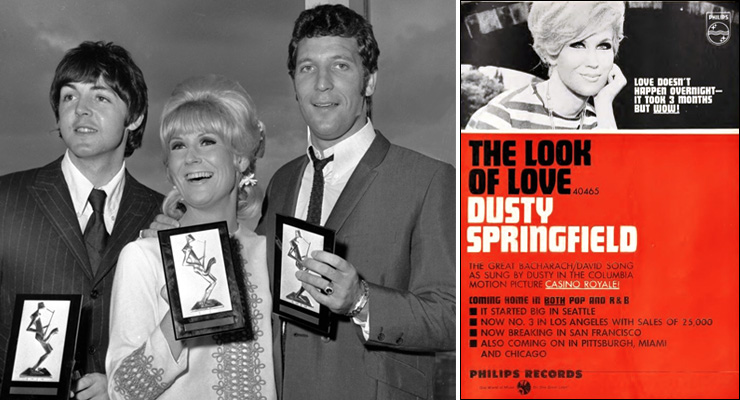 |
|
ABOVE: (left) 13
September 1966 – ‘Bonding’ at the Melody Maker Pop
Poll Awards Paul McCartney, who would later write and perform the
title song for Live And Let Die (1973) accepted the award
for Best Group (The Beatles), with Dusty Springfield (top female
vocalist) who would record ‘The Look of Love’ in January
1967; and Tom Jones (top male vocalist) who had sung the title song for Thunderball
(1965). Tom Jones was a last-minute replacement for Dionne Warwick
whose version of ‘Mr. Kiss Kiss Bang Bang’ was to have
been the main theme, until the producers decided that the film title
needed to be in the song. (right) A US advertisement for Dusty
Springfield's single version of ‘The Look of Love’. The Philips
Records single version became a big hit in the USA reaching number
22 on ‘Billboard's Hot 100’. ‘The Look of Love’ was released in
the UK in May 1967 as the the
‘B-side’ to ‘Give Me Time’ but did not chart. Dionne Warwick would
record her own cover version of ‘The Look of Love’
released on the album Dionne Warwick's Greatest Motion Picture
Hits in 1969. The album was produced by Burt Bacharach, and
contained several cover versions of hit songs written with Hal
David. |
|
|
|
Casino Royale
Is Too Much For One Single!
The last day of the
recording sessions for Casino Royale was reserved for Dusty
Springfield’s vocal of ‘The Look of Love’. This alternate arrangement was
recorded at an evening session at Philips Studios, located in the basement
of Stanhope Place, rather than CTS. It is likely that the change of
venue was because Dusty Springfield was contracted to the Philips record
label, and as a rule all Philips artistes recorded at the company’s own
studio. The single
version of ‘The Look of Love’ was released in the USA (Philips 40465) and
became a big hit, but when the song was issued in the UK (Philips BF 1577)
for some unknown reason the order of the two songs on the single were
reversed, and ‘The Look of Love’ became the B-Side to ‘Give Me Time’ and
consequently the record failed to chart. No doubt due to its popularity in
the USA, ‘The Look of Love’ was nominated for an Academy Award as Best
Song, but singer Dusty Springfield was unable to perform at the
1968 Oscar ceremony as she was busy working on her hit ITV
Television show It Must Be Dusty at the time. The 40th Academy
Awards hosted by Bob Hope were held at the Santa Monica Civic Auditorium
on April 10, 1968, to honour film achievements of 1967. Originally
scheduled for April 8th, the ceremony was postponed for two days due to
the assassination of civil rights leader Martin Luther King Jr. ‘The Look
of Love’ was
performed at the awards ceremony by Sergio Mendes and
Brasil '66. The Latin-Jazz group later recorded their own version of ‘The Look
of
Love’ released in the USA in 1968 (A&M 924). One of the members of Sergio Mendes and
Brasil '66 was Lani Hall, wife of Herb Alpert who would
later perform the title song for Never Say Never Again in 1983. Dusty Springfield's version of ‘The Look of Love’
lost out at the Oscars to ‘Talk To The Animals’ from Doctor Dolittle (1967),
which had music and lyrics by Leslie Bricusse. The prolific English
composer, lyricist, and playwright had co-written ‘Goldfinger’ in 1964
with John Barry and
Anthony Newley; and also the lyrics for ‘You Only Live
Twice’, sung by Nancy Sinatra in the other James Bond film released in
1967. Bricusse later told lyricist Hal David that he thought ‘The Look of
Love’ should have won as it was ten times better than his own song. In
2008 Dusty Springfield's version of ‘The Look of Love’ was inducted into
the Grammy Hall of Fame. |
Before the Dusty Springfield UK Philips record release, a cover version of ‘The Look of Love’ by
Roland Shaw
& His Orchestra was the first 45rpm single issued on March 31, 1967 with
an instrumental interpretation of ‘Have No Fear, Bond Is Here’ as the
B-side. The 45rpm single (Decca F 12595) cover version of ‘The Look of
Love’ later appeared on Roland Shaw's 1971 compilation album
The World Of
James Bond Adventure (Decca SPA 158). Roland Shaw (1920-2012) and his
orchestra released several Bond albums on the Decca label between 1966 and
1971; these were not only versions of John Barry’s themes, but also Shaw’s
own interpretations of other tracks from the film soundtracks. His ‘Big Band’
arrangements were the English equivalent of the recordings by US Jazz legend Count Basie
(1904-1984)
on his
popular
Basie Meets Bond album from 1966.
Another cover version of ‘The Look of Love’ was released on April 4, 1967,
this time recorded by singer and actress Shani Wallis on the London Records label (HLR
10125), with ‘Let The Love Come Through’ as its B-side. Wallis
recorded the songs just before playing Nancy in Carol Reed's 1968 film
version of Lionel Bart's hit
stage musical
Oliver!. Originally composed by Burt Bacharach and Hal David as
a theme for Casino Royale, ‘Let The Love Come Through’ was rejected
by producer Charles K. Feldman, but an instrumental version remained in
the film and features in the sequence where Mata Bond (Joanna
Pettet) and
Carlton-Towers (Bernard Cribbins) arrive in Berlin. The music also ended
up on the original soundtrack album as the second half of the track
‘Flying Saucer – First Stop Berlin’. |
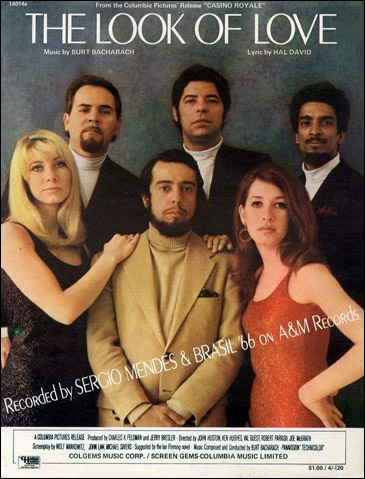 |
|
Sheet music
for the 1968 A&M Records single release of ‘The Look of
Love’ by Sergio Mendes & Brasil '66 (A&M 924). |
|
|
|
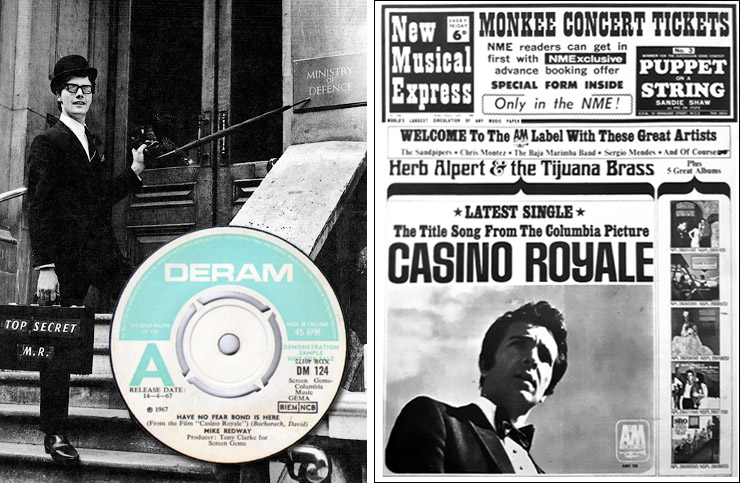 |
|
ABOVE: (left) Mike Redway in a publicity pose for his novelty record ‘Have No Fear,
Bond Is Here’ released on April 14, 1967. The song appears over
the end credits of Casino Royale (1967) but was not
included on the original soundtrack LP. The single was originally
played in cinema foyers to bewildered customers waiting to see the
film. (right) The front cover of the April 1st edition of the
New Musical Express announcing the release of the title song
from Casino Royale by Herb Alpert & the Tijuana Brass. |
|
|
|
On April 14, 1967, the
day after the World Premiere of
Casino Royale
at London's ODEON Leicester Square, yet
another 45rpm single containing music from the film was
released. The novelty single ‘Have No Fear, Bond Is Here’ was sung by
Mike Redway who had performed the song for the film, but this recording did
not end up on the original soundtrack album. Redway's vocals are also heard
briefly during the dream sequence where Evelyn Tremble (Peter Sellers) is
drugged by Vesper Lynd (Ursula Andress), and appear as part of the
penultimate track on the original soundtrack album as ‘Dream On
James, You're Winning’. Redway performs a portion of ‘Have No Fear, Bond Is
Here’ over the end credits in the film. Redway's contribution to Casino
Royale
went uncredited on screen, but the track ‘Have No Fear, Bond Is Here’ now
appears on the
2017 50th Anniversary expanded CD release of the soundtrack released
by Quartet Records. The promotional single was originally played in cinema
foyers to bewildered customers waiting to see Casino Royale, and
has slightly different lyrics (written by Hal David) to the version heard
over the end credits of the film. |
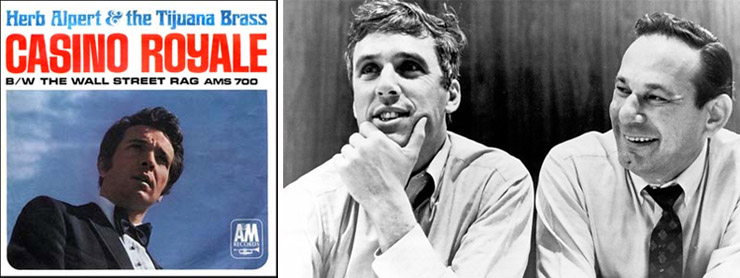 |
|
ABOVE: (left) Bond
Connections - The original UK 45rpm single record of ‘Casino
Royale’ by Herb Alpert & the Tijuana Brass released in April 1967
on the A&M label. Herb Alpert also played trumpet on the title
song for Never Say Never Again (1983) which was sung by his
wife Lani Hall. (right) Burt Bacharach who composed the musical
score for Casino Royale (1967) with Hal David (1921-2012)
who provided the lyrics to ‘The Look of Love’, and ‘Have No Fear,
Bond Is Here’. In 1969 Hal David
wrote the lyrics for ‘We Have All The Time In The World’ composed
for the film On Her Majesty's Secret Service by John Barry.
Hal David also provided the lyrics to ‘Do You Know How Christmas Trees
Are Grown?’ sung by Nina Van Pallandt in the same film. Hal David
was re-united with John Barry when he wrote the lyrics for
the title song
‘Moonraker’, sung in the 1979 film by Shirley Bassey.
|
|
|
|
The final 45rpm single
with original music from Casino Royale was released in the UK in
late
April 1967 as the film went on general release. Herb Alpert & the
Tijuana
Brass recording of the main title theme was issued by A&M records (AMS
700). It was originally intended to add the ‘Have No Fear, Bond Is Here’
lyrics to the backing track Burt Bacharach had already recorded with the
assembled musicians during the CTS sessions, and have Johnny
Rivers sing the song. Rivers had recorded ‘Secret Agent Man’ as the title
song played on the US screenings of Patrick McGoohan's British TV
series Danger Man, replacing Edwin Astley's jaunty title track
‘High Wire’, that played over the titles when the series aired in the UK.
Although announced in the press, the American Rock 'n' Roll singer turned
down the offer claiming that the song was terrible. Eric Burdon, lead
singer with the popular English group ‘The
Animals’ also recorded ‘Have No Fear, Bond Is Here’ on the evening of January
25, 1967, but this was rejected by lyricist Hal David as Burdon had not
properly learned the song and his short-lived connection to the
film was never publicized. However, an unidentified vocalist performs the
lyrics to ‘Have No Fear, Bond Is Here’ on
a US radio spot for the film -
could this be the demo version heard by Johnny Rivers, or
a fragment of the lost Eric Burdon and ‘The Animals’ recording? |
 |
Casino Royale radio spot featuring ‘Have No Fear, Bond Is
Here’ sung by Mike Redway and an unidentified second singer...
[from 1.10 onwards] could this be the demo version of the song
heard by Johnny Rivers, or is it Eric Burdon of ‘The Animals’? |
|
|
|
The producers eventually
settled on the instrumental version of the title theme performed by easy
listening exponent Herb Alpert who, together with his backing band the
‘Tijuana Brass’, had popularised a Mexican brass sound in the mid-1960s.
Bacharach later played his backing track over the telephone to Alpert, who
was in New York, suggesting it could be augmented by his distinctive brass
sound. A master tape was forwarded to Alpert, who simply double-tracked
his trumpet and added some light percussion before returning it to London.
All of this took just three days. It is believed that the musicians who
made up the ‘Tijuana Brass’ did not perform on the track, despite being
credited along with Alpert, under what appears to have been a contractual
agreement at the time. Apparently members of the ‘Tijuana Brass’ did spend
two days in a Los Angeles studio in February 1967 recording their own
version of ‘Casino Royale’, but this appears to have been shelved,
presumably because the Bacharach version already recorded in London was
superior. |
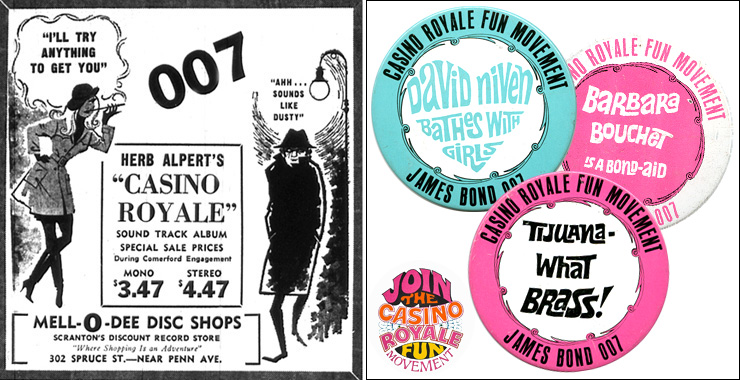 |
|
ABOVE: (left) Newspaper advertisement promoting the
Casino Royale soundtrack album which was discounted at the
Mell-O-Dee Discs record store during the films three-week engagement at
the Comerford cinema in Scranton, Pennsylvania from Wednesday May
31, 1967. (right) As part of the Casino Royale
publicity campaign a set of metal badges were issued, one of
which featured the ‘Tijuana Brass’.
BELOW: The
Casino Royale soundtrack was chosen as the record of the
month in September 1967 by the RCA Victor Record Club,
and sent to subscribers of the ‘Popular’, ‘Broadway’ and
‘Hollywood & TV’ categories. |
|
 |
|
|
The A&M single and
Colgems soundtrack album received four Grammy nominations in 1967 for
‘Instrumental Theme’, ‘Instrumental Performance’, ‘Instrumental
Arrangement’ and ‘Original Score’, but lost out in all categories.
However, Burt Bacharach did win in the ‘Best Instrumental Arrangement’
category for his version of ‘Alfie’. Burt Bacharach later released his own
Casino Royale related record in 1967 after signing to A&M Records.
The independent record label was co-founded by Herb Alpert and Jerry Moss
(1935-2023) in 1962. Bacharach's LP Reach Out contained a track called
‘Bond Street’ which was actually a reworking of ‘Home James, Don’t Spare The
Horses’ featured on the original Casino Royale soundtrack.
‘Bond
Street’ was issued
as a single in the UK (AMS 702), with Bacharach's Grammy-winning ‘Alfie’
as its B-side. The UK album Reach Out (AMLS 908) also contained
Bacharach's own instrumental version of ‘The Look of Love’. |
 |
|
Varese Sarabande CD
VSD-5265 (1990) |
Varese Sarabande CD
VSD-5265 (2002) |
Quartet Records CD
QRSCE037 (2012) |
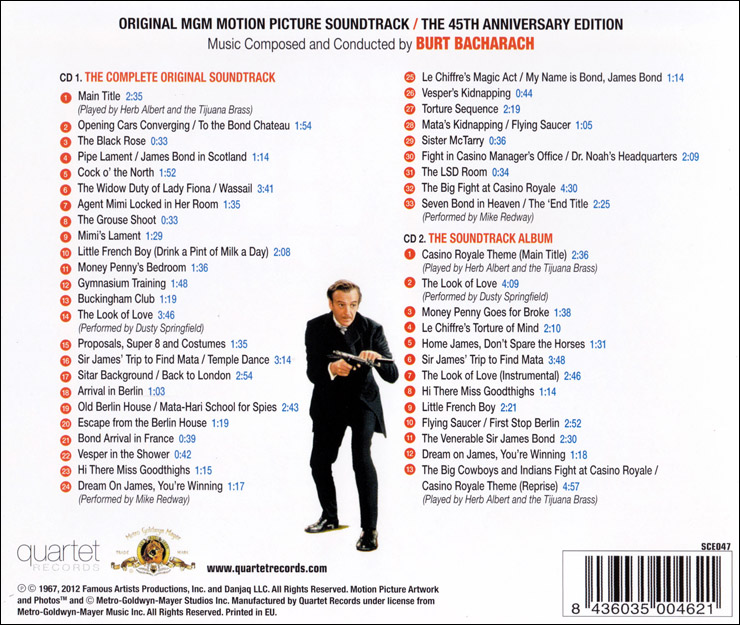 |
|
ABOVE: Casino
Royale Is Too Much For One CD - (top L-R) The original 1990 CD
from Varese Sarabande was a direct digital transfer from the
original album master tapes so the track listing was identical to
the 1967 LP version. Varese re-issued this CD in 2002 with a
different cover. The Quartet Records 2012 45th Anniversary Edition
featured the most complete version of the soundtrack then
released, including tracks sourced from materials found in MGM's
vault. (bottom) The track listing for the 2012 45th Anniversary CD
from Quartet Records which included a version of the
original album on disc 2 mastered from the materials used to
create the Spanish LP in 1967. The tracks were identical to the US
Colgems release, but the sound quality was inferior. |
|
|
|
It is a testament to the
quality of the recording of the
Casino Royale soundtrack, both aurally and aesthetically, that it has been
re-issued several times on CD since its initial 1990 release. Independent
American label Kritzerland re-issued the soundtrack in 2011 (KR
20017-6), this time offering the score in two presentations. On the first
half of the CD, Bacharach’s music was presented in film order, with
material not on the original Colgems album including the climactic song
performed by Mike Redway, ‘Have No Fear, Bond Is Here’. The second half of
the CD featured the original LP sequence, mastered from a mint vinyl copy,
with no added EQ or processing. Limited to just 1,000 copies the
Kritzerland edition sold out almost immediately. In 2012 Spanish label
Quartet Records announced that they had discovered two
different DMEs [Dialog-Music-Effects] in MGM’s vaults, and although the
music stems were in mono, they were in excellent condition, except for the
obligatory volume shifts required for the sound mixing of the final film
soundtrack. Using sophisticated software tools Quartet were able to
remix these tracks to consistent sound levels. Controversially Quartet
chose to then issue the new tracks in artificial stereo, with
the standard album
version on disc 2. The 45th Anniversary CD (QRSCE037) came in a slip-cased
package including an 8-page full colour booklet and a separate 64-page
full colour book analyzing Burt Bacharach's iconic score. The Quartet
double-CD edition was limited to 1,500 copies and again sold out very
quickly upon its February 2012 release. Quartet Records later
re-issued the same double-CD in a non-limited edition (SCE047) in October
2012, but this time featuring a newly remastered version of the original
LP album recording in place of the Spanish LP master used on their earlier
release. |
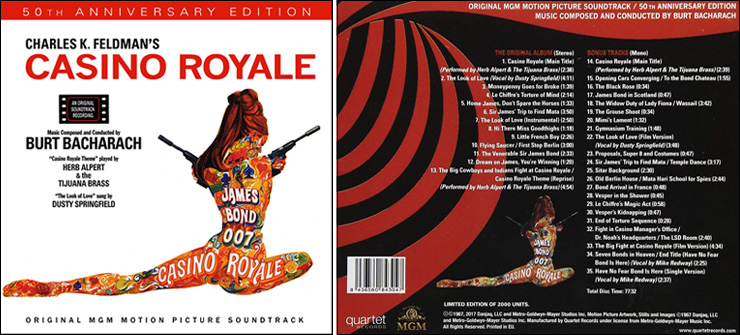 |
|
For the 50th anniversary
of Casino Royale in 2017, Quartet Records revisited the
soundtrack once again and issued another limited edition (QR304), this
time the complete score was rebuilt from the DME sound stems with no
additional processing. The CD starts
with the LP recording in stereo, followed by the
film tracks as a bonus programme; this time in
mono without adding any stereo reverb. The single-CD 50th anniversary
edition dropped a couple of bagpipe interludes
(‘Pipe Lament’ & ‘Cock O' The North’) from the film score as they were not
composed by Burt Bacharach, and did not include those
tracks already in stereo which existed
as part of the LP album
sequence. The result was the best-sounding and most technically
accomplished edition of Casino Royale on CD yet released.
This time limited to 2,000 copies, it is ironic that the film which
divides fans has had the most individual and comprehensive CD releases of
any James Bond film, with varying degrees of audio excellence. The 50th
anniversary edition therefore contains all of Burt Bacharach's music
recorded for Casino Royale (1967), including a bonus track making
its CD debut - the promo-single version of ‘Have No Fear, Bond Is Here’ by
Mike Redway, also arranged by Bacharach. In 2019 Quartet Records
released Casino Royale on black vinyl as a double-LP with a
gatefold sleeve. Replicating the content of the 2017 50th Anniversary CD,
this edition was limited to just 500 copies and sold out almost
immediately. |
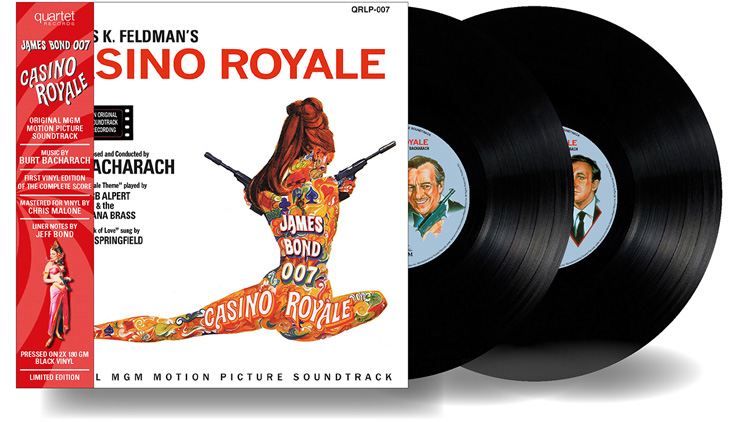 |
|
On August 29, 2025,
Quartet Records announced a Limited Edition re-issue of the 2019
official complete vinyl edition of Burt Bacharach’s timeless classic
soundtrack, this time in blue and orange coloured vinyl. Once again housed
in a gatefold jacket retaining the iconic original cover art by Robert
McGinnis, limited to just 500 copies and now sold out. The package included liner notes
by Jeff Bond, and a separate insert with a tech-talk by Chris Malone. The
first LP is a fully remastered re-issue of the iconic original stereo
vinyl, with the second LP containing all the unreleased material in mono. |
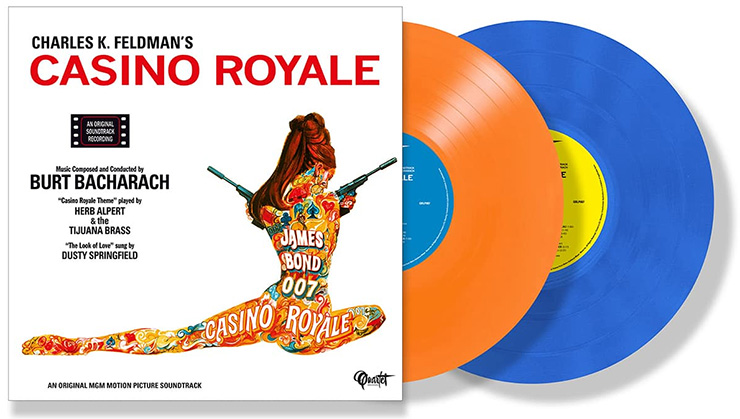 |
|
More than half-a-century
after its original release the soundtrack to Casino Royale is still
highly sought after in its various incarnations. Sadly the same cannot be
said of Michel Legrand's lacklustre score for Sean Connery's ill-advised
1983 comeback as James Bond in Never Say Never Again. The film did
not have a soundtrack release in the USA or Europe but a 42-mnutes LP of
highlights was released in Japan. It was not until 1993, when Never Say
Never Again first appeared on a 62-minute CD
only from Silva Screen Records America, and two years later in the
UK. This version of the soundtrack contained several cues not heard in the
film. Lani Hall's title song did have a 45rpm single released at the time
Never Say Never Again was in cinemas, but failed to chart on
both sides of the Atlantic. The title song ‘Never Say Never Again’ was
produced by Lani Hall's husband Herb Alpert, along with Sergio Mendes
(1941-2024). |
|


